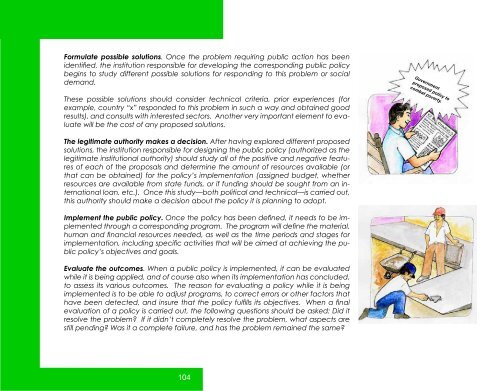in English - Handicap International
in English - Handicap International
in English - Handicap International
Create successful ePaper yourself
Turn your PDF publications into a flip-book with our unique Google optimized e-Paper software.
Government<br />
proposed policy to<br />
combat poverty.<br />
Formulate possible solutions. Once the problem requir<strong>in</strong>g public action has been<br />
identified, the <strong>in</strong>stitution responsible for develop<strong>in</strong>g the correspond<strong>in</strong>g public policy<br />
beg<strong>in</strong>s to study different possible solutions for respond<strong>in</strong>g to this problem or social<br />
demand.<br />
These possible solutions should consider technical criteria, prior experiences (for<br />
example, country “x” responded to this problem <strong>in</strong> such a way and obta<strong>in</strong>ed good<br />
results), and consults with <strong>in</strong>terested sectors. Another very important element to evaluate<br />
will be the cost of any proposed solutions.<br />
The legitimate authority makes a decision. After hav<strong>in</strong>g explored different proposed<br />
solutions, the <strong>in</strong>stitution responsible for design<strong>in</strong>g the public policy (authorized as the<br />
legitimate <strong>in</strong>stitutional authority) should study all of the positive and negative features<br />
of each of the proposals and determ<strong>in</strong>e the amount of resources available (or<br />
that can be obta<strong>in</strong>ed) for the policy’s implementation (assigned budget, whether<br />
resources are available from state funds, or if fund<strong>in</strong>g should be sought from an <strong>in</strong>ternational<br />
loan, etc.). Once this study—both political and technical—is carried out,<br />
this authority should make a decision about the policy it is plann<strong>in</strong>g to adopt.<br />
Implement the public policy. Once the policy has been def<strong>in</strong>ed, it needs to be implemented<br />
through a correspond<strong>in</strong>g program. The program will def<strong>in</strong>e the material,<br />
human and f<strong>in</strong>ancial resources needed, as well as the time periods and stages for<br />
implementation, <strong>in</strong>clud<strong>in</strong>g specific activities that will be aimed at achiev<strong>in</strong>g the public<br />
policy’s objectives and goals.<br />
Evaluate the outcomes. When a public policy is implemented, it can be evaluated<br />
while it is be<strong>in</strong>g applied, and of course also when its implementation has concluded,<br />
to assess its various outcomes. The reason for evaluat<strong>in</strong>g a policy while it is be<strong>in</strong>g<br />
implemented is to be able to adjust programs, to correct errors or other factors that<br />
have been detected, and <strong>in</strong>sure that the policy fulfills its objectives. When a f<strong>in</strong>al<br />
evaluation of a policy is carried out, the follow<strong>in</strong>g questions should be asked: Did it<br />
resolve the problem? If it didn’t completely resolve the problem, what aspects are<br />
still pend<strong>in</strong>g? Was it a complete failure, and has the problem rema<strong>in</strong>ed the same?<br />
104

















